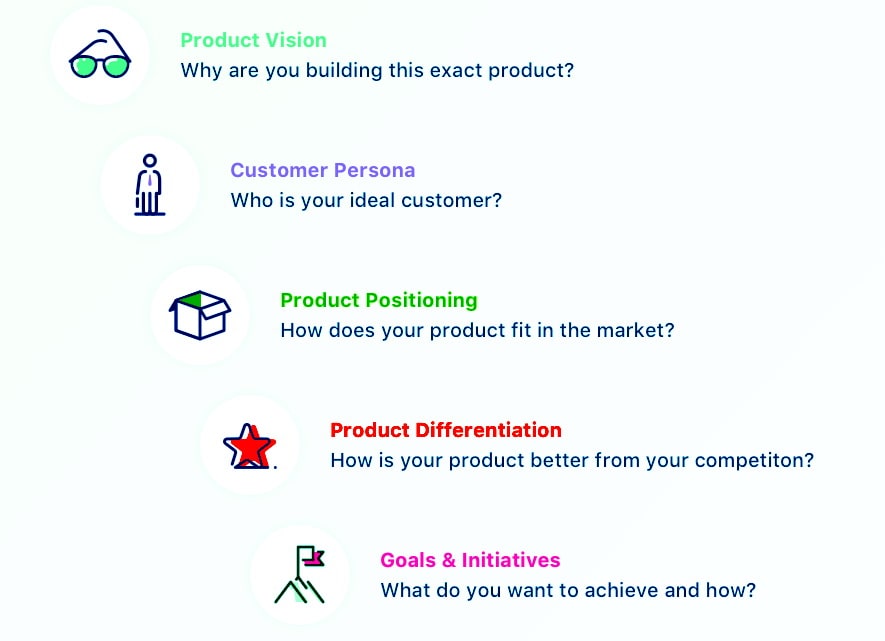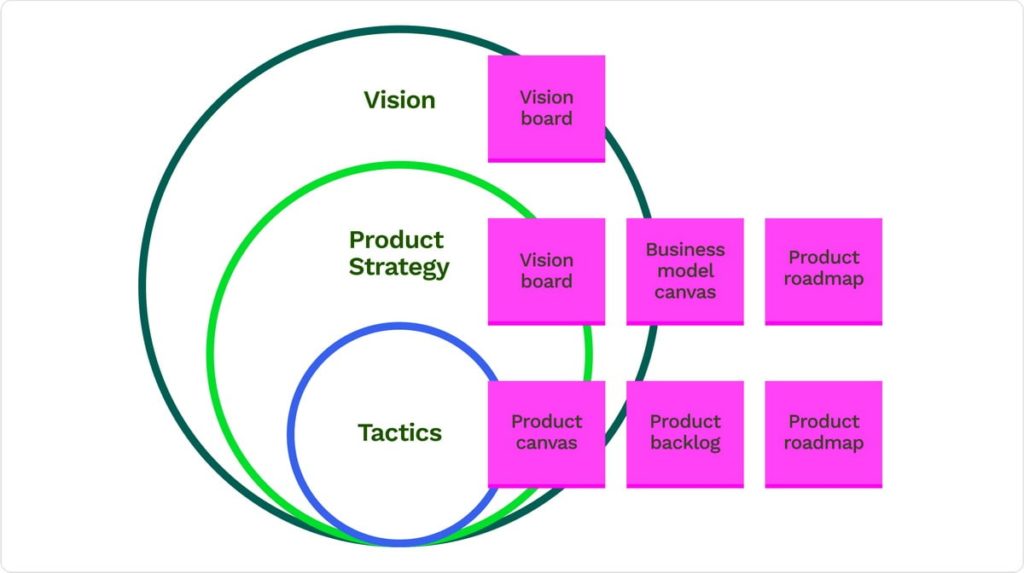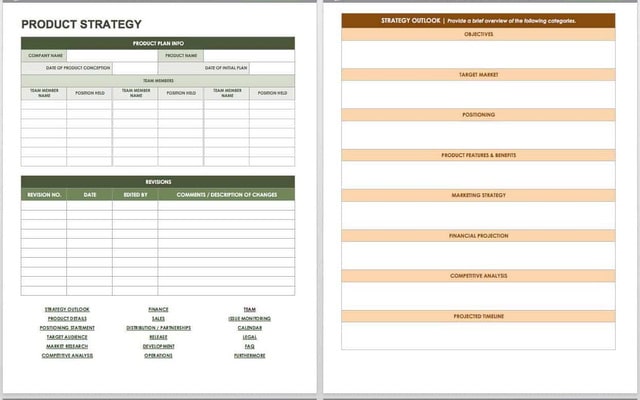Product Strategy Guide: 7 Steps to Build a Powerful Strategy

Introduction
Welcome to our free guide on building a powerful product strategy.
Today is essential for companies to have a clear direction and purpose for their products. A well-defined product strategy not only aligns teams but also ensures that their efforts are focused on achieving the desired outcomes. In this guide, we will explain what a product strategy is, its benefits and importance, key elements to consider, where it fits in the development plan, effective business models, steps to build an effective product strategy with examples, and why a fine-tuned product strategy is key to product success. Let’s get started!
What is a Product Strategy?
A product strategy is a high-level plan that defines the direction and goals of a product. It outlines the value the product aims to deliver to customers, the target market it serves, and the differentiation from competitors.
A product strategy provides a roadmap for the development and evolution of the product over time. It helps teams understand where they should focus their energy and resources, enabling them to make informed decisions throughout the product lifecycle.
Benefits and Importance of a Product Strategy
Having a well-defined product strategy brings several benefits to businesses.
Firstly, it provides clarity and purpose to the entire organization. It aligns teams and stakeholders on the vision and goals of the product, fostering a shared understanding and commitment. This alignment enhances collaboration and improves decision-making, leading to more efficient and effective product development.
Secondly, a product strategy helps prioritize efforts and resources. By defining the most important features and functionalities, businesses can allocate their resources wisely, ensuring that the product delivers the maximum value to customers. It also enables teams to make trade-off decisions when faced with constraints, such as time or budget limitations.
Furthermore, a strong product strategy enhances the ability to adapt to market changes. It enables businesses to stay ahead of the competition by anticipating shifts in customer needs and preferences. With a clear strategy in place, teams can respond quickly and effectively to market dynamics, ensuring the product remains relevant and competitive.
In summary, a product strategy:
- Provides clarity and purpose to the organization.
- Aligns teams and stakeholders.
- Enhances collaboration and decision-making.
- Prioritizes efforts and resources.
- Enables adaptation to market changes.
- Ensures product relevance and competitiveness.
Key Elements of a Product Strategy
A comprehensive product strategy should consider the following key elements:
- Vision: The long-term vision describes the desired future state of the product and aligns with the overall business objectives. It answers the question, “Where do we want the product to be in the future?”
- Goals and Objectives: Clear and measurable goals and objectives help define what the product aims to achieve. These should be aligned with the vision and provide a roadmap for success.
- Target Market: Identifying the target market is crucial for understanding the needs, preferences, and characteristics of the customers the product intends to serve. This information guides product development and marketing strategies.
- Competitive Analysis: Analyzing the competitive landscape helps identify the strengths, weaknesses, opportunities, and threats posed by competitors. This analysis informs product differentiation strategies and identifies areas for innovation.
- Value Proposition: The value proposition defines the unique value the product offers to customers. It communicates how the product solves their problems, fulfills their needs, or improves their lives. A compelling value proposition sets the product apart from competitors.
- Product Roadmap: A product roadmap outlines the major features, functionalities, and milestones that will be delivered over time. It provides a high-level overview of the product’s evolution, ensuring a coherent and strategic approach to development.
By considering these key elements, businesses can create a robust product strategy that guides their decision-making and helps them stay on track toward their goals.

Where Does Product Strategy Fit in the Development Plan?
Product strategy plays a pivotal role in the development plan of a product. It sets the foundation and direction for the entire development lifecycle. Ideally, the product strategy should be defined before the development process begins and inform all subsequent activities.
The product strategy influences the prioritization of features and functionalities during development. It guides the product backlog, ensuring that the most valuable and impactful items are addressed first. By aligning development efforts with the product strategy, businesses can optimize their resources and maximize the value delivered to customers.
Throughout the development plan, the product strategy acts as a reference point to evaluate progress and make adjustments as needed. It provides a lens through which teams can assess whether their work aligns with the overall goals and vision of the product. This alignment ensures that the product remains on track and delivers the intended outcomes.
So, the product strategy is the guiding force that shapes the development plan and ensures that efforts are focused on achieving the desired results.
Effective Product Strategy Business Models
When creating a product strategy, businesses can consider different models based on their goals and market dynamics. Some effective product strategy business models include:
- Market Segmentation: This model focuses on targeting specific customer segments with tailored products or features. By understanding the unique needs and preferences of different market segments, businesses can create customized offerings that resonate with each group.
- Product Differentiation: This model emphasizes creating a unique and differentiated product that stands out from competitors. It involves identifying key features, functionalities, or experiences that set the product apart and provide a compelling value proposition.
- Innovation and Disruption: This model focuses on introducing groundbreaking innovations or disrupting existing markets with new solutions. It involves identifying unmet needs or underexplored market opportunities and developing products that address them in novel ways.
- Platform or Ecosystem: This model involves building a platform or ecosystem that enables the integration of complementary products or services. By creating a cohesive ecosystem, businesses can offer a comprehensive solution that provides additional value to customers.
- Lifecycle Management: This model involves strategically managing a product throughout its lifecycle, from introduction to retirement. It includes continuous updates, enhancements, and adaptations to meet changing customer needs and market dynamics.
It’s important for businesses to evaluate these business models in the context of their industry, target market, and competitive landscape. By choosing the most suitable model, businesses can maximize the impact of their product strategy and achieve long-term success.
Steps to Build an Effective Product Strategy with Examples
Building an effective product strategy involves a structured approach. Here are the steps to guide you along the process:
- Market Research: Conduct thorough market research to understand customer needs, preferences, and pain points. Analyze the competitive landscape and identify trends and opportunities. This research provides a solid foundation for developing a successful product strategy.
- Define Vision and Goals: Based on market research, define a clear vision for the product. Outline specific goals and objectives that align with the vision and provide a roadmap for success. For example, a vision could be to create a user-friendly mobile app that simplifies task management, while a goal could be to acquire 100,000 active users within the first year.
- Identify Target Market: Identify the target market or customer segments the product will serve. Develop a deep understanding of their demographics, behaviors, and needs. This information will guide product development and marketing strategies.
- Analyze Competition: Conduct a thorough analysis of the competitive landscape. Identify key competitors, their strengths and weaknesses, and the opportunities and threats they present. This analysis helps identify product differentiation strategies and areas for innovation.
- Craft Value Proposition: Develop a compelling value proposition that communicates the unique value the product offers to customers. Clearly articulate how the product solves their problems, fulfills their needs, or improves their lives. For example, a value proposition could be “Our product streamlines project management, saving teams valuable time and increasing productivity.”
- Create Product Roadmap: Develop a product roadmap that outlines the major features, functionalities, and milestones that will be delivered over time. Prioritize the roadmap based on the identified market needs and the product’s value proposition. A well-designed roadmap ensures a strategic and coherent approach to development.
- Align and Communicate: Ensure that the product strategy is effectively communicated and understood by all stakeholders, including development teams, marketing teams, and executives. Regularly align the execution with the product strategy and provide updates as needed.
Remember, an effective product strategy is a dynamic document that evolves as the market and customer needs change. Regularly review and update the strategy to ensure it remains relevant and aligned with the overall business objectives.

Why a Fine-Tuned Product Strategy is Key to Product Success?
A fine-tuned product strategy is essential for product success. It provides a clear direction, aligns teams, and ensures that efforts and resources are focused on achieving the desired outcomes. Here’s why a well-defined product strategy is key:
- Focus and Prioritization: A product strategy helps teams understand where they should focus their energy and resources. It prioritizes efforts by identifying the most important features and functionalities that will deliver maximum value to customers. This focus ensures that teams work on the right things at the right time.
- Alignment and Collaboration: A product strategy aligns teams and stakeholders on the vision and goals of the product. It fosters collaboration and improves decision-making by providing a shared understanding and commitment. When everyone is working towards a common goal, the chances of success increase significantly.
- Adaptability and Market Relevance: A fine-tuned product strategy enables businesses to adapt to market changes and stay ahead of the competition. By anticipating shifts in customer needs and preferences, companies can respond quickly and effectively. Regularly evaluating and updating the product strategy ensures that the product remains relevant and competitive.
- Efficiency and Resource Optimization: A clear product strategy optimizes the allocation of resources. It helps businesses make informed decisions about resource allocation, ensuring that efforts are focused on delivering the most value. This optimization improves efficiency and maximizes return on investment.
So, as you can see, a fine-tuned product strategy is crucial for product success. It provides focus, alignment, adaptability, efficiency, and optimization, ultimately driving the product toward its goals and delivering value to customers.
Download the Product Strategy Template
To assist you in creating an effective product strategy, I have prepared a Product Strategy Template. This template will guide you through the process, providing a structured format to capture and organize your strategy. To download the template, please send a request to agileandscrummasterclass | @ | gmail.com, and I will promptly send it to you.
Conclusion
Building a powerful product strategy is essential for businesses to achieve their goals and deliver value to customers.
A well-defined product strategy provides clarity, aligns teams, and prioritizes efforts and resources.
By considering the key elements of a product strategy, understanding its importance and benefits, and following a structured approach, businesses can create a robust strategy that guides their product development and leads to success.
Remember, a fine-tuned product strategy is not a one-time exercise but an ongoing process that requires regular evaluation and adaptation. Embrace the power of a strong product strategy and turn your vision into reality.
Don’t forget to subscribe to our newsletter down below or to check our BLOG.
Product strategy provides a clear direction and purpose for Agile teams, guiding their efforts and ensuring alignment with overall business objectives.
A product strategy defines the “why” and high-level goals, while a product roadmap outlines the “what” and provides a more detailed plan of features and milestones.
A well-defined product strategy aligns teams, prioritizes efforts and resources, enhances collaboration, and enables businesses to adapt to market changes effectively.
Market research helps businesses understand customer needs, preferences, and market trends, providing valuable insights that shape the product strategy and increase its chances of success.
Regularly reviewing and updating the product strategy ensures its relevance in a dynamic market, allowing businesses to adapt and respond to evolving customer needs and competitive landscapes.
